The Big Book of Pain: Torture & Punishment Through History (54 page)
Read The Big Book of Pain: Torture & Punishment Through History Online
Authors: Daniel Diehl

BOOK: The Big Book of Pain: Torture & Punishment Through History
11.16Mb size Format: txt, pdf, ePub
Below that is a headcage which would have been used as a restraint device as well as a form of public humiliation (similar to the brank shown earlier and the scold’s bridle discussed later).
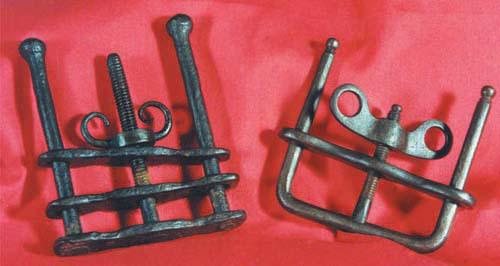
At the bottom of the page we see two very well-preserved examples of thumbscrews. While the thumbscrews in the image at the top of the page have a loop to serve as an attachment point for restraint, those at the bottom of the page are likely to have been created for the sole purpose of inflicting pain.
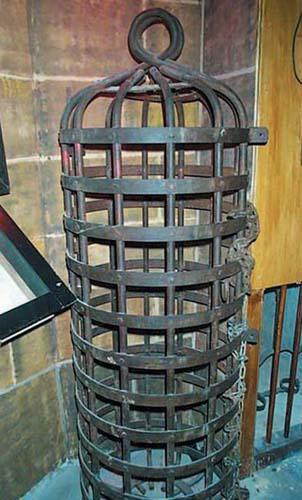

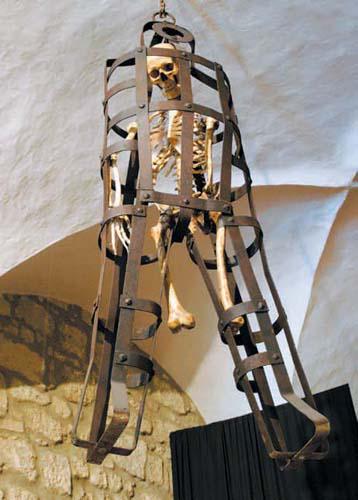
Here we see a variety of iron cages. These are properly referred to as gibbets, though the term can be somewhat confusing as hanging gallows and very early guillotines were occasionally called gibbets. Whether bodies were placed in these devices following execution for public display or a living victim was locked within to die of exposure, it was public spectacle which encouraged the use of these devices.
Gibbetting was common law punishment, which a judge could impose in addition to execution. It was most often used for traitors, murderers, highwaymen, and sheepstealers, to discourage others.
The structures were therefore often placed adjacent to public highways. Although the intention was deterrence, the public response was complex. Samuel Pepys expressed disgust at the practice. There was Christian objection that persecution of criminals should end with their death. The sight and smell of decaying corpses was offensive, and regarded as ‘pestilential’, so a threat to public health. In some cases, the bodies would be left until their clothes rotted or even until the bodies were almost completely decomposed, after which the bones would be scattered.
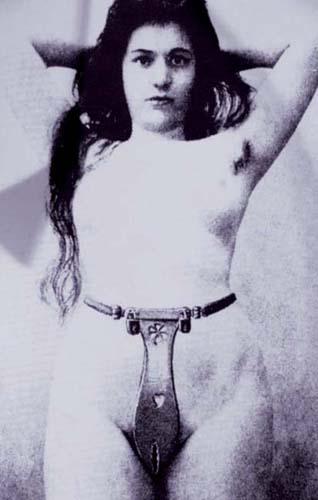

The first known mention of chastity belts in the Western world is in Konrad Kyeser von Eichstätt’s Bellifortis, (
c.
1400) which describes the military technology of the era. The book includes a drawing (see below) that is accompanied by the Latin text: ‘
Est florentinarum hoc bracile dominarum ferrcum et durum ab antea sic reseratum
.’ (‘These are hard iron breeches of Florentine women which are closed at the front.’)
The common myth about early chastity belts is that they were used by crusaders travelling to the holy land, to ensure the fidelity of their wives who awaited their return. This seems rather implausible, since those early belts were very uncomfortable, and it seems very unlikely that they could be worn for extended periods of time. Another, more plausible, theory suggests that the belts were used by the women themselves to protect them against rapes during times such as the surrender of a city following a siege.
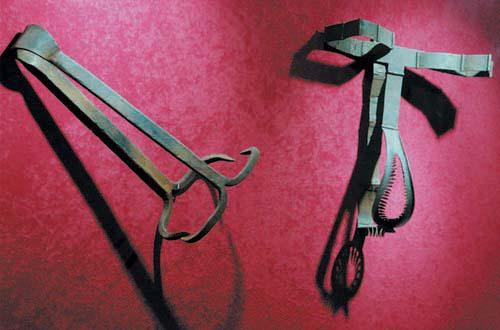
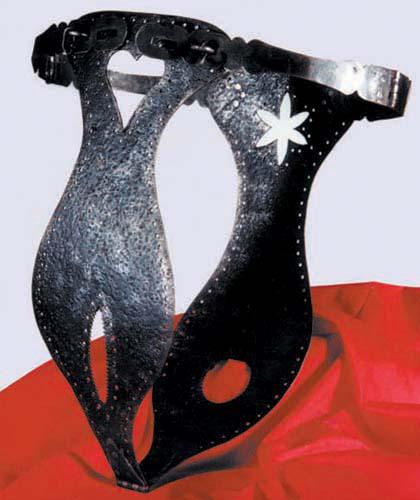
‘Girdle of Purity’. ‘Girdle of Venus’. ‘Florentine Girdle’: some of the names of the device better known as the Chastity Belt. While not an object used in the dungeon, the belt was responsible for more than its fair share of anguish. The image on the right depicts a design in which the front (vaginal) opening is quite small in order to allow fluids to escape but only very small objects could enter. The example depicted on the right of the top image, however, has a larger opening but one which is studded with very sharp teeth.
Above on the left is an entirely different sort of torture device designed specifically for female anatomy. This device is referred to as a breast ripper. This item was used both as a punitive and an interrogational device. Punitively, it was used red-hot to mark the breast of unmarried mothers. In an inquisitory nature claws were used, either cold or heated, to punch and tear at an accused woman’s bare breasts.

Here we have a truly spectacular piece of craftsmanship. Whether or not chastity belts were locked on women by men who were worried about their fidelity or by the women themselves as protection against rape, it is open to interpretation whether these devices fall into the category of torture. But no matter which interpretation you take, there is no denying the beauty of the design and workmanship of this gilded example.
We may be tempted to consider these objects as barbaric relics of a distant past, but consider the following: In April 2002, the Uwe Koetter Jewellers company of Cape Town, South Africa completed and delivered a spectacular diamond and pearl-encrusted chastity belt made of gold to a British customer. The belt reportedly cost 160,000 African Rand and was a wedding gift from a husband-to-be for his bride to wear at their wedding.
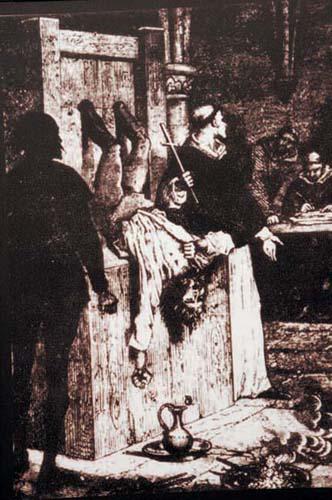
Other books
Until Thy Wrath Be Past by Asa Larsson
Necromantic by Vance, Cole, Gualtieri, Rick
Moon Tortured (Sky Brooks Series Book 1) by McKenzie Hunter
The Menagerie #2 by Tui T. Sutherland
Viking Heart (The MacLomain Series: Viking Ancestors Book 3) by Sky Purington
One Voice 02 - Here Without You by Mia Kerick
Leavin' Trunk Blues by Atkins, Ace
The Avenger 22 - The Black Death by Kenneth Robeson
MURDER IN THE SPOTLIGHT (Food Truck Mysteries Book 2) by Chloe Kendrick
Of Sea and Cloud by Jon Keller
